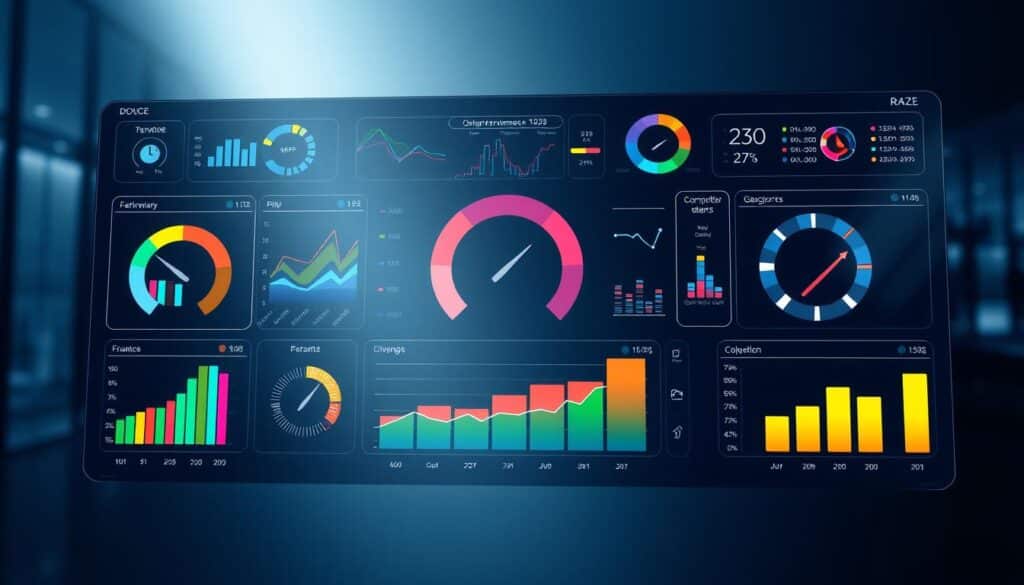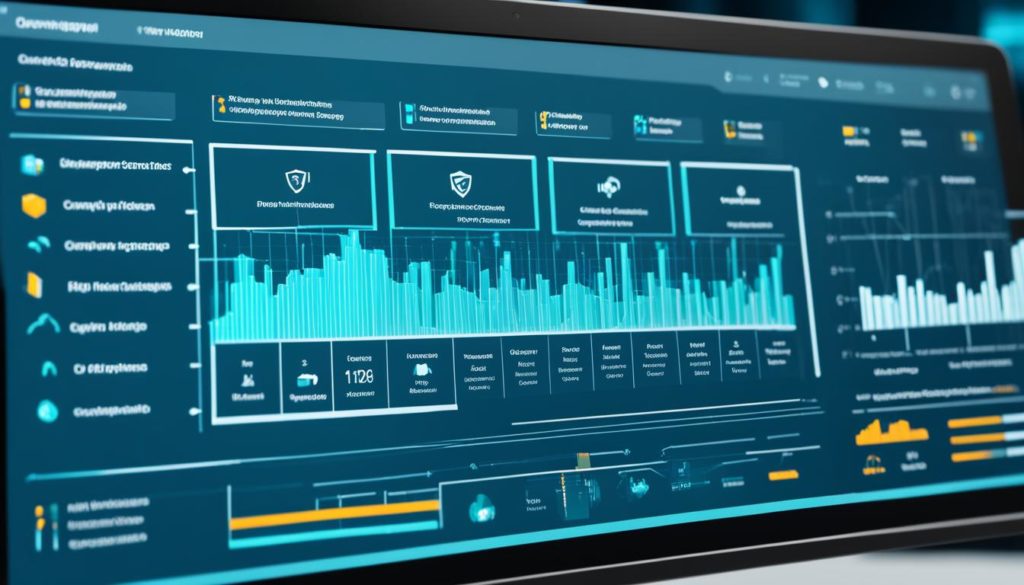
Did you know that big names like Google, Toyota, and HSBC use Key Performance Indicators (KPIs)? They do this to improve their plans, thanks to Bernard Marr’s insights. KPI management is key to guiding a business towards success. We’ll look at what KPIs are and why they’re important for business strategies and better performance.
Bernard Marr is a top expert on KPIs, with 18 best-selling books under his belt. He’s worked with giants like AstraZeneca, HSBC, and T-Mobile. His work helps these companies track their performance better and reach their goals. Marr’s approach teaches us how to use KPIs to boost business success.
KPIs are not just for big companies. They’re crucial for all businesses, from new startups to big players. Marr says, “Companies using KPIs can track, check, and tweak their plans to hit their targets.”
For more on KPIs, check out a detailed guide on Mastering Key Performance Indicators (KPIs). It offers practical tips and insights for businesses to grow and succeed with KPIs.
Key Takeaways
- KPIs are key for checking and judging business performance against goals.
- Big names like Google, Toyota, and HSBC use KPIs for success.
- KPI management helps businesses tweak and improve their strategies.
- Bernard Marr’s KPI expertise is in demand by top organizations.
- A detailed guide on mastering KPIs is available here.
Grasping and using KPIs can change a business’s game. Let’s dive into the basics and advanced ways to use these vital performance tools.
Understanding the Basics of KPIs
Key performance indicators (KPIs) are important data points that show how well different business operations work. Knowing about these metrics is key for any company wanting to reach its goals and work better. We’ll look at what KPIs are and why they’re so important for success.
Definition of KPIs
Peter Drucker said, “What gets measured gets done.” This shows how vital KPIs are. They are measurable signs of progress toward goals. KPIs help set goals and check if we’re getting there, which is crucial for making good decisions and getting better.
KPIs can be leading or lagging indicators. Leading ones show future success, while lagging ones measure past success. It’s important to use both to get a full picture of how well a company is doing. KPIs cover many areas like how well things are done, how fast, and if they follow rules.
Importance of KPIs in Business
KPIs are key for making sure business actions match up with goals. They help make decisions and guide growth. Finding the right KPIs lets companies check if they’re doing things well and efficiently.
Strategic measures look at long-term goals, like happy customers and financial health. Operational measures help with daily choices, like using resources well. Using both kinds of KPIs helps keep performance balanced.
KPIs do more than just measure; they help improve. They show where changes are needed and where to grow. With KPIs, companies can handle today’s fast-changing business world better.
Creating Effective KPIs
Creating effective Key Performance Indicators (KPIs) starts with knowing their purpose. KPIs are key indicators that help track progress towards goals. Let’s explore how to develop and use KPIs well in your organization.
Setting Clear Business Objectives
The first step is to set clear, measurable business goals. These goals should match your organization’s overall strategy. Using tools like the Balanced Scorecard or SMART criteria can help a lot.
The Balanced Scorecard Institute’s MPRA framework stresses the need for a shared vision and clear goals. When we define our objectives well, we can pick the right performance indicators. These indicators help make strategic decisions.
The MPRA framework also talks about setting targets and improving. It’s about regularly checking how well we’re doing to meet our goals. This cycle makes our KPIs dynamic tools for ongoing improvement.
Difference Between KPIs and Metrics
It’s important to know the difference between metrics and KPIs for good performance management. Metrics track ongoing processes, while KPIs focus on strategic goals and outcomes.
Good KPIs give us insights and help us make decisions. For example, a sales manager might track if printer buyers also buy ink. This KPI can shape marketing and sales strategies, affecting revenue. Regularly checking these KPIs keeps them relevant to our goals.
By knowing the difference between metrics and KPIs, we focus on what really matters for business success. For more on KPIs and their role in sales, check out this detailed guide.
Choosing the Right KPIs for Your Business
Choosing the right Key Performance Indicators (KPIs) is key to aligning your business strategies with your goals. By picking KPIs that match your company’s objectives, you can track progress well. Let’s dive deeper into this.
Aligning KPIs with Strategic Goals
Good KPIs should directly tie to your strategic goals. This makes them meaningful and useful. Avoid just using standard indicators. Instead, focus on specific goals for users, customers, and your business.
For example, a B2B software company might focus on customer acquisition cost (CAC) and customer lifetime value (CLV). On the other hand, a B2C e-commerce business might look at website traffic and conversion rates.
Quantitative indicators like daily active users give solid data for comparison. Qualitative indicators, like user feedback, help understand why certain outcomes happen. Also, balancing revenue with technical debt guides future strategies. Review and adjust KPIs every three months to keep them relevant as your goals change.
The SMART Criteria for KPIs
Using SMART KPIs makes your KPIs more effective. SMART stands for Specific, Measurable, Attainable, Relevant, and Timely. Let’s see how each part helps:
- Specific: KPIs should be clear and focused. For example, tracking open bugs in a software team shows product health.
- Measurable: Use numbers, like customer acquisition rate or average order value, to track performance easily.
- Attainable: Set achievable targets to keep your team motivated. Avoid vanity metrics that don’t add value.
- Relevant: Make sure KPIs match your strategic goals. For startups, growth metrics like MRR and user growth rate are key.
- Timely: KPIs should have a clear timeline for evaluation. Tracking customer response time and resolution rate improves satisfaction.
By using SMART KPIs, businesses can make sure their indicators are actionable and aligned with goals. This leads to a strong framework for growth and success.
Key Performance Indicators (KPIs) in Different Industries
Knowing the right Key Performance Indicators (KPIs) is key for many industries. By choosing the right metrics, companies can work better and reach their goals. Let’s see how this works in retail, healthcare, and tech.
Examples of KPIs in Retail
In retail, KPIs are vital for checking and boosting performance. They track sales, customer interaction, and stock levels.
- Sales Growth: Looking at sales changes over time.
- Customer Engagement: Checking social media, loyalty programs, and feedback.
- Inventory Management: Watching stock turnover and shrinkage.
Using these KPIs helps managers make smart choices. This ensures the business stays profitable and keeps customers happy.
Examples of KPIs in Healthcare
In healthcare, KPIs are key for checking patient care and how well things run. Important metrics include:
- Patient Satisfaction: Looking at feedback through surveys and scores.
- Operational Efficiency: Watching hospital stay times and bed use.
- Financial Metrics: Tracking margins and costs per discharge.
These metrics help hospitals and clinics improve care and run smoother. This leads to better healthcare for everyone.
Examples of KPIs in Technology
In tech, KPIs measure innovation, market reach, and money matters. Common KPIs are:
- Innovation Rate: Counting new products or features each year.
- Market Penetration: Looking at market share and getting new customers.
- Financial Performance: Checking growth with EBITDA and revenue goals.
By using these KPIs, tech companies can stay ahead and keep growing and innovating.
KPI Dashboard and Templates
As we conclude our guide on Key Performance Indicators (KPIs), let’s look at tools like KPI dashboards and templates. These tools make tracking easier and data more accessible. Many companies have seen big improvements in their performance by using these tools.
Benefits of Using a KPI Dashboard
A KPI dashboard gives a clear view of your business. It combines financial and process metrics in one place. Studies show 92% of businesses find it better for seeing how healthy their company is.
Strategic dashboards give a broad view, while operational ones show real-time data. Analytical dashboards find the causes of changes. Using these dashboards can save up to 30% of time and effort.
Popular KPI Templates
Using KPI templates can make tracking more efficient. 76% of businesses say they align better with their goals. Companies like Klipfolio and Tableau offer customizable templates.
These templates make reports clear and easy to use. This is key for making good decisions. 82% of successful companies check their KPI dashboards daily or weekly.
Having a strong performance tracking plan with a good KPI dashboard and templates can change your business. With 85% of companies tracking KPIs easily, now is the time to use these tools. They help improve and align your business, leading to success.
FAQ
What are Key Performance Indicators (KPIs)?
KPIs are important data points that show how well a business is doing. They help track progress towards goals.
Why are KPIs important for business success?
KPIs are key for planning and tracking performance. They help businesses see how they’re doing and make better decisions.
How do we set clear business objectives for KPIs?
To set clear goals, identify specific, measurable targets. These goals help create KPIs that reflect your business strategy.
What is the difference between KPIs and regular metrics?
KPIs are tied to business goals and show success. Metrics are general data for monitoring business operations.
How do we align KPIs with our business’s strategic goals?
Align KPIs with goals by making sure each supports a main objective. This focus ensures success.
What is the SMART criteria for KPIs?
SMART criteria make KPIs Specific, Measurable, Attainable, Relevant, and Timely. This helps create effective KPIs for strategic decisions.
Can you provide examples of KPIs for retail businesses?
Retail KPIs include sales growth, customer engagement, and average transaction value. These metrics track performance and efficiency.
What are some examples of KPIs in the healthcare sector?
Healthcare KPIs are patient satisfaction, readmission rates, and treatment success. These show quality of care and hospital performance.
How do tech companies use KPIs to measure performance?
Tech companies track innovation, market penetration, and customer acquisition costs. These KPIs measure growth and advancements.
What are the benefits of using a KPI dashboard?
KPI dashboards make it easy to see performance. They help spot trends and make informed decisions. They make data accessible.
What are some popular KPI templates?
Popular templates include balanced scorecards and Excel dashboards. They help track and visualize performance metrics.
Future App Studios is an award-winning software development & outsourcing company. Our team of experts is ready to craft the solution your company needs.










